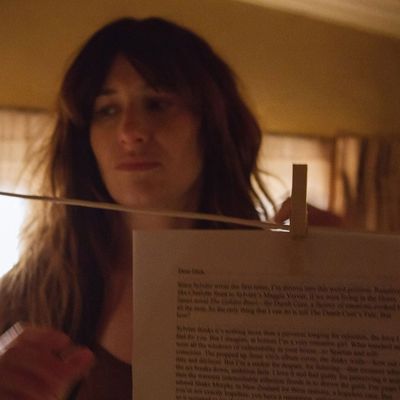
“There are 500 times as many female nudes in art history textbooks as there are female artists.” So says Toby toward the end of this episode, which takes the objectification of women in art and life as its theme. Part of what makes Chris Kraus’s book (and now this show) so revolutionary is that it’s a product not of the male gaze, like all those prints in the art-history books, but of the female one, with Dick as the objectified babe.
Every woman in Marfa seems to see Dick as a symbol of something different. They all have fantasies in which he plays a starring role. Paula fantasizes about him validating her work as a curator. Toby fantasizes about beating him at his own game. Devon fantasized about being him when she was a kid, and maybe still does. Chris, as we already know, fantasizes about sex with him. “A Short History of Weird Girls” takes a break from the main narrative to chronicle the back stories of these four women, each in the form of a letter to Dick.
Chris’s letter pulls back the curtain on her sexual evolution. “I’ve been horny since I was six,” she tells the audience, deadpanning at the camera in the middle of the stark West Texas landscape. As she recounts her various affairs (with a stuffed animal, with a rock star), we see that her need to demand attention and intimacy from partners who do not fully reciprocate did not begin with her arrival on the plains.
Her first Dick, as it were, was a stuffed rhino. She liked to hump it in front of her babysitter Karen. Something about the feeling of being watched excited her even then. Her next threesome didn’t come until after college, when she and her friend made up their minds to bed a rock star. They told him they wanted to create a “living representation” of feminist sculptor Louise Bourgeois’s The Couple, a major aluminum work which shows two sets of legs dangling below a pair of spiraling torsos that have melded together. The point of the project seemed fairly lost on the rock star, although he did get one thing right. “You’re weird girls,” he tells them, wagging his finger lecherously. As we know, this would not be the last time Chris would try to make art of out of something sexual.
Sylvère was the first man who didn’t dismiss Chris as weird. “Nothing freaked him out,” Chris remembers, and you begin to understand the roots of their connection. It turns out that the film she submitted to Venice was based in some ways on these early encounters, but her memory of those days is far warmer than her film suggests. Unlike the bored fat man in her movie, Sylvère was lithe and vibrant, twiddling his toes in excitement as he engaged her in post-coital discussion of philosophy. In bed, he tells her to remove her clothing, ordering her to keep her boots on. He lies back and watches Chris touch herself. The present-day Chris, striking in a bold red dress, suddenly enters the scene and has a look around, like Woody Allen in the flashback sequences of Annie Hall. Watching Sylvère watch her younger self, her face is impassive, analytical. Does she like what she sees? It’s impossible to say.
“A Short History of Weird Girls” opens with a clip from the 1999 short film Removed, by Naomi Uman. To make it, Uman went through reels of ’70s pornography and erased the images of women from every frame using nail-polish remover and bleach. What’s left are shots of men observing and caressing a glowing, ghostly presence — or more accurately, an absence. In Chris’s flashback scene, Soloway employs Uman’s technique so that Chris herself becomes an omission, a ghost. It’s an enigmatic moment that speaks to the older Chris’s efforts to untangle herself from Sylvère’s powerful gaze.
In the early stages of their relationship, Chris loved seeing herself through Sylvère’s eyes. But a year after they got married, they stopped having kinky sex; five years after that, the sex stopped altogether. Today, Chris says, she doesn’t want to see herself through any man’s eyes. “I don’t care how you see me,” she tells her fantasy image of Dick, who sits naked on his couch, barely covered by one of his Navajo blankets. “I don’t care if you want me. It’s better that you don’t. It’s enough that I want you.”
Dick plays a totally different role in Devon’s life. She doesn’t want to sleep with Dick; she wants to become him. She first saw him when she was five years old and immediately recognized his sexual charisma. “I loved watching you play cowboy with all your women,” Devon tells us, and we see how Devon’s whole slow, swaggering, sexy style can be traced to Dick’s influence. Her family’s relationship with Dick goes back too — her grandparents and great-grandparents worked on his family’s land. When her female cousins want to practice kissing, Devon pretends she’s Dick. In the present, narrating in a red jumpsuit, Devon observes Dick cozying up to a pretty blond, and then taps his shoulder and takes his place. The memory gets darker when she comes home to find Dick walking out of her mother’s bedroom.
Devon puts on a good Dick act, but she’s incapable of playing it cool when she really wants somebody, as is the case with her college girlfriend, a pretty cello player. When the cellist shifts her gaze to a boy named Gabe, Devon, devastated, drops out of school, abandoning her dream of becoming a playwright. She goes back to Texas to try to figure out what to do with her life, working odd jobs at the institute in the meantime. It’s not until Chris comes to town that Devon decides to take another stab at writing a play.
Paula backs into her Dick story by first telling us about how, as a young girl, she fell out of love with her mother when she saw a tampon string dangling from her crotch one night. Why is this so distressing to Paula? It seems to have something to do with the frank explicitness of the image. Paula, we come to understand, does not like things to be clearly defined. Instead of following her mother around, she turns the closet into a cozy reading nook and locks herself inside. As she reads, she touches herself. “I didn’t have a word for it,” she said. “All I knew was that it felt good.” The day she learned that this was called masturbation, she didn’t want to do it anymore. “Naming it was literally the least sexy thing I could imagine.” Dick, we learn, never titles his pieces, and it’s this refusal to be defined and named that draws Paula to his work, which provokes in her a feeling of “boundlessness.”
But when she comes to Marfa to work with him as the curator at the institute, his laconic style proves to be a bummer. He won’t offer much in the way of guidance or support. He often says nothing at all to her suggestions. Their relationship is hardly the dynamic collaboration she envisioned. It’s as though she’s invisible to him. “I’m still here,” she proclaims in her letter, “searching for something you’ll say yes to.”
Toby begins her letter by listing Dick’s accomplishments — his scholarship to the San Francisco Art Institute, his MacArthur Genius grant, and so on. Dick’s work, she says, is primarily about reminding the world of the size of his “massive steel and concrete cock.” He embodies “everything anyone has ever wanted from a late 20th century alpha-male artist and scholar.” Toby projects something close to disdain for the “remote, mysterious, unknowable cowboy.” Yet she knows so much about him because her hippie parents had one of his coffee-table books. (It was her favorite.)
She leads us on a tour of her funky childhood home in Santa Fe. Her pot-smoking dad was “an expert on children, so he thought he was allowed to touch me,” she coolly remarks. Her cousin Tara introduced her to porn, and thus Toby’s obsession was born. As a precocious art-history major at Columbia, she began her formalist study of hardcore pornography, which prompted her frowning male professors to urge her to move into the gender-studies department. Refusing to be marginalized in this way, she holds fast to her vision and launches a promising career. Her letter ends on a taunting note. “You haven’t made a piece in nearly a decade. Your time is running out. Dear Dick, we are not far from your doorstep.”
Film clips, in order of appearance
I Love Dick weaves short clips from avant-garde feminist directors throughout each episode. Sometimes, those clips blend into the story lines unfolding in Marfa; other times, they’re used for contrast. In each recap, we’ll identify them.
1) Naomi Uman, Removed
2) Naomi Uman, Leche
3) Cauleen Smith, Chronicles of a Lying Spirit (By Kelly Gabron)
4) Petra Cortright, enchanted foreststrippersnopeleeasy2girls[1]





